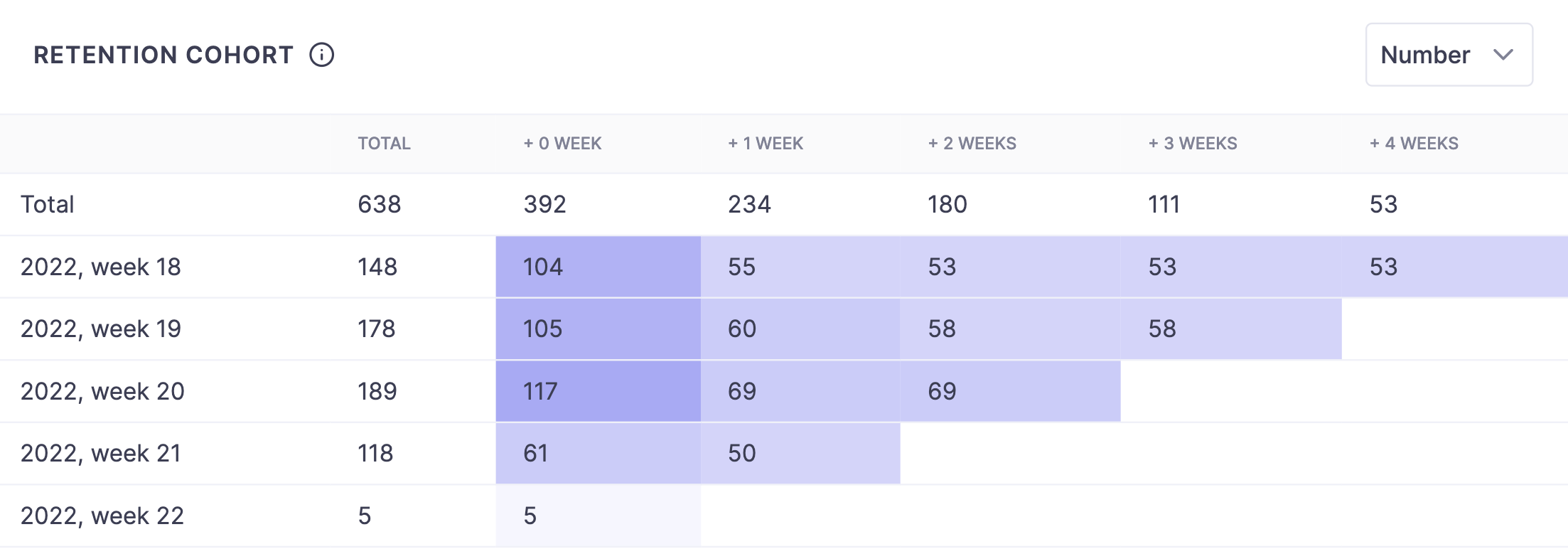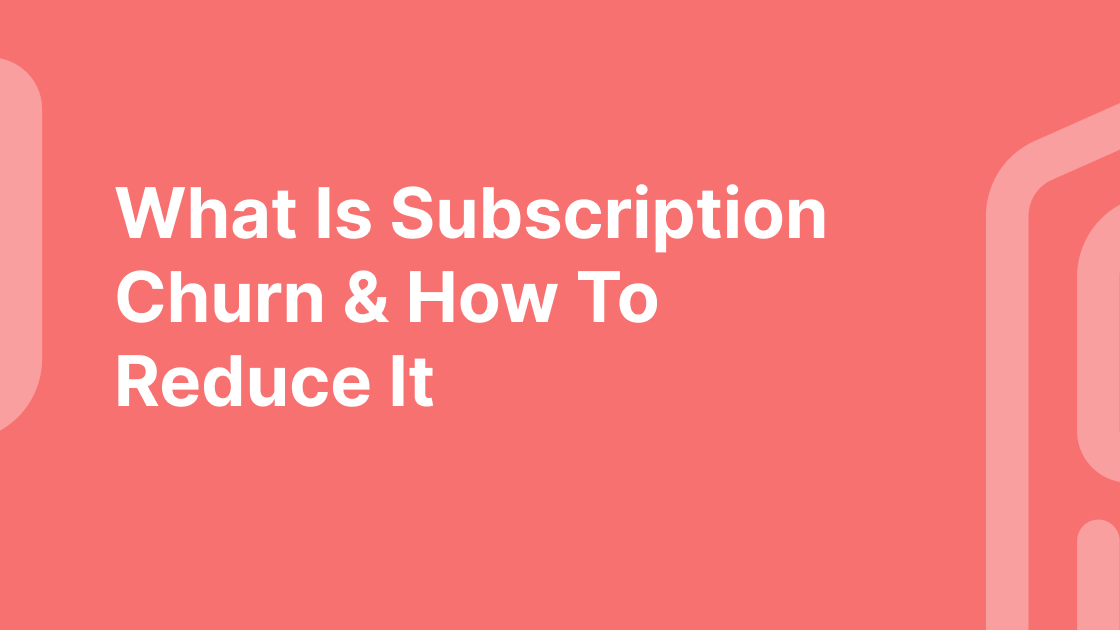If you're a marketer or developer, you know that subscriber churn is a huge challenge. Losing subscribers can impact your bottom line and even put your business at risk. Learn about the different types of subscription churn and how to reduce them.
Ready for some sobering statistics?
In 2021, the average app lost 77% of its Daily Active Users (DAUs) within the first three days after install. This increased to 90% after 30 days, and 95% after 90 days.
In other words, most apps lose the vast majority of their users within the first few days.
So while downloads and installs are important metrics to track in order to understand your app’s acquisition rate, it’s measuring, understanding, and ultimately reducing subscription churn which is the key to long-term sustainable growth for your app.
So what exactly is subscription churn and how do you measure it? Are there different kinds of subscription churn you need to measure? And what are the most effective strategies to reduce it? Find out below in our guide to subscription churn.
Summary
1. What is app subscription churn?
2. How to calculate subscription churn rate: 3 formulas to use
3. Types of subscription churn rates to measure
4. What causes churn?
5. Churn industry benchmarks
6. Conducting retention cohort analysis
7. How to reduce voluntary churn
8. How to reduce involuntary churn
9. Takeaways
What is app subscription churn?
Churn rate essentially means user turnover. It tells you the number of users who stop using your mobile app over a given period of time.
In subscription terms, it’s a metric that lets you know how many active subscribers opt to end their relationship with your app. We’re talking about voluntary churn here, but there are instances where however, there are instances where subscribers involuntarily churn too, which we’ll look at later in this article.
Churn is an important metric that gives product teams an assessment of whether or not users are enjoying their app, and executive teams an assessment of retention and how much revenue an app is making. Churn is normal, no app or company can avoid it entirely. But consistently high churn rates are not good. If subscription apps can’t keep their customers, then it signals there is a problem with the app experience, which can negatively impact revenue and growth goals.
How to calculate subscription churn rate: 3 formulas to use
On the surface, calculating churn rates seems pretty straightforward: divide the number of churned subscribers by the total number of subscribers, right?
The problem is there isn’t a single type of subscriber(e.g. new subscribers vs. active subscribers coming up for subscription renewal). And there are factors to take into consideration that may skew your churn rate e.g. new subscribers typically churn at a higher rate than subscribers who have stuck around for 2 weeks or longer.
Other factors to consider include time frames used (are you looking at churn rate over a week, month, quarter or year?), external factors such as seasonality or an app feature release or bonus content. All of these factors can skew churn rate, which is why there are a number of different formulas you can use.
Key:
Churn = number of subscribers that churned within time period.
n = number of days in time period.
Subscribers = number of subscribers on any given day e.g. subcribers(1st day) is the total number of subscribers on the first day of the time period.
1. The simple way
Divide the total number of churned subscribers over a given period by the number of subscribers you had on the first day of that given period.
Churn rate = Churners / Subscribers(1st day)
This is the most simple way of calculating subscriber churn rate. You can do it quickly to get an overview of where you’re at in terms of retention and churn. But this calculation doesn’t deal well with high-growth companies where both churn rate and total number of subscribers can increase significantly. It can lead to skewed interpretations where you’re losing more at-risk subscribers, but your churn rate will look better.
2. The adjusted way
Here you divide the number of churned subcribers by an adjusted average.
Churn rate = Churners / [(Subscribers(1st day) + Subscribers(Last day))/*2]
This normalizes the change in total subscribers, giving you a more stable platform on which to base the churn rate.
Often, teams that are in charge of monitoring subscription business are using the number of subscribers at the beginning of the period and the number of subscribers ath the end of the period to compute the adjusted average number of subscribers associated to that period.
The problem with this approach is that it doesn’t adjust well for different time periods i.e. you’ll get a different churn rate for daily, weekly and monthly churn - despite using the same data and formula.
3. Purchasely’s way: the most accurate
As Purchasely is able to collect data at the most granular level (per subscriber) and in real-time, Purchasely has the capability to compute the average subscriber base for any kind of period.
Let’s take the example of a weekly churn.
On one hand, Purchasely will compute each day of the week the number of active subscribers, therefore the right average number of subscribers which is:
Average[Subscribers(Days 1 to 7)] =
[Subscribers(Day 1) + Subscribers(Day 2) + Subscribers(Day 3) + Subscribers(Day 4) + Subscribers(Day 5) + Subscribers(Day 6) + Subscribers(7)]/7.
On the other hand, Purchasely will add daily churners for the same time window.
Therefore,
7-day Churn Rate =
Sum[Churners(Days 1 to 7)] / Average[Subscribers(Days 1 to 7)]
The beauty of that approach is that it might be applied to any time window: calendar weak, 7 days rolling, monthly, 30 days rolling, quarterly, 90 days rolling, yearly, 365 days.
If the subscripton app is operating a very large volume of subscribers, the Purchasely way might be used to compute Daily or Hourly churn rates.
Types of subscription churn rates to measure
There are a few different definitions of churn when it comes to subscription businesses. Let’s take a quick look at what each of them mean below:
Subscriber churn
Subcribers churn rate is the percentage of subscribers who stop using your company’s app over a given period of time. This includes both voluntary and involuntary churn, and so gives an overall view of the health of an app’s user base. It’s less useful as a metric when it comes to making data-driven decisions on how to reduce churn.
Revenue churn
Revenue churn rate is the amount of monthly recurring revenue (MRR) lost because of subscription cancellations. It is also called MRR churn or monthly churn and is typically calculated monthly. Two types of cancellations should be distinguished: voluntary and involuntary.
Voluntary churn
This is when a customer actively chooses to end their subscription. This can happen for a number of reasons, such as not finding the app useful anymore, not being satisfied with the product, or finding a cheaper alternative. It’s your job to analyze the data and find out why users are churning so you can improve the user experience.
Involuntary churn
This is when a subscriber accidentally churns because of a payment failure due to an expired card or insufficient funds in their account. While voluntary churn usually accounts for the larger percentage of churned subscribers, involuntary churn is still a big problem for many subscription businesses.
Revenue contraction
By adding the revenue lost due to subscription downgrades to that Revenue Churn, a subscription app may monitor its Contraction MRR, the decrease of revenue generated by churned subscribers and downgraders.
What causes churn?
Every user is different, of course. But some of the most common reasons users cancel a subscription and uninstall an app include:
-
App isn’t “sticky” enough - this is the most significant reason users churn. They simply aren’t using the app enough. This could mean your onboarding isn’t effective enough, engagement efforts aren’t working, or there are perhaps bigger problems with the value proposition or app quality.
-
Too many ads or notifications - ads and push notifications play an important role pre-subscription. The goal of freemium apps is to get users to become paid customers and subscribe to the app. But modern users are sensitive to too many ads that can appear aggressive.
-
Technical issues - Bugs are inevitable when it comes to software. But it doesn’t stop users from cancelling their subscriptions if they experience too many. Make sure apps undergo a rigorous beta testing phase before launch, continually test post-launch and when new features are released, and keep a close eye on crash reports.
-
Confusion - Everybody has had a confusing UI experience, whether on a website or mobile app. It’s another friction point that can cause users to opt out. So make sure you have a team of UX researchers who are able to uncover problems and opportunities in the app interface design.
-
Poor customer service - In today’s digital economy, the customer experience is key. Ensuring your app has a responsive, helpful, and friendly customer service team is critical to ensuring a positive customer experience.
The good news is that you can do something about it. Ask for user feedback to find out directly why users are cancelling their subscriptions and use mobile analytics features like funnels and flows to understand the friction points for your users.
Churn industry benchmarks
As we’ve said, churn is simply a fact of life for any subscription business. The big question is…what is a healthy churn rate? As we saw above, there are many definitions and assesment methods of churn.
So let's step aside and look at the 1-year retention rate which is the % of customers that still pay to access your product and services after 12 months.
Below are some key retention trends and benchmarks curated by GP Bullhound (source: 2022 Consumer Subscription Software) that should provide some insight for your business:
Conducting a retention cohort analysis
Establishing your baseline rates of churn using the formulas outlined above is the first step. To find out where to focus your retention efforts, you need to dig a little deeper into the details. The best way to do that is with retention cohort analysis.
What does “cohort” mean? It’s just a fancy word for “group”. So when we say “cohort analysis”, we mean breaking down users into groups and analyzing specific user behaviour.
This could be anything you want:
-
Customer acquisition channels (which channel are your most engaged users coming from? organic trafffic? paid ads?)
- Date of subscriber acquisition (last day, last week, last month)
-
Time it takes to convert
-
Actions (what actions do your most engaged users take? create an account, number of sessions per a specific time period? number of contents?, etc.)
The Purchasely dashboards provide different criteria to segment your subscribers base and to assess the retention rate of any cohort defined by :
- Countries
- iOs vs Android
- Type of pricing plans (trial, premium, renewable, non renewable)
- Duration of pricing plans (weekly, monthly, quarterly, yearly)
Retention cohort provided by Purchasely

For example, the granular approach of Purchasely enables dating apps to assess the evolution of weekly retention of a cohort of subscribers acquired during the week of Black Friday with a time-limited special offer in a specific country and to compare that evolution with the default control group
Essentially, cohort analysis shows you how subscribers are keeping engaged with your app, which gives you valuable insights gives you can use to improve user engagement, retention - and reduce churn.
How to reduce voluntary churn
Yes, the million-dollar question. In the old “wild west” days of subscriptions, lots of companies used to make churning difficult for users: obscuring opt-out information, requiring users to call customer service, creating multi-step cancellation processes.
Thankfully, we’ve moved on. User experience is the new king. So to reduce voluntary churn, subscription apps need to analyze their workflows to see where they are churning and prevent them from getting to that point in the first place. Here are some concrete ways to do just that.
1. Segment your at-risk subscribers
Modern analytics platforms allow you to create subscriber segments for engaged and at-risk users. This segmentation makes it easy for you to prioritize where to focus your attention, with at-risk users likely requiring more of a hands-on approach.
2. Personalize interactions
One-size-fits all campaigns are a thing of the past. Users demand highly personalized content that’s relevant to their experience. One way of doing this might be showing a user exactly how many times they’ve read premium content as a way to encourage users to stay and not cancel their subscription.
3. Real-time event notifications
Triggered push notifications - especially ones that are personalized - are effective ways of boosting engagement. For example, if there’s a big drop-off in subscription renewals after the third month, it might be a good idea to send an event-triggered notification after a user’s second-month renewal to encourage switching to a yearly plan.
4. Prioritize existing relationships
You know the maths: it costs a lot more to acquire a new subscriber than to retain one. So investing more in your existing subscriber base than in your acquisition cycle will yield far greater returns. Regular outreach and feedback from your subscribers will give you insights to work with. There are also other things such as loyalty programs, educational resources such as free webinars, or communities, that will help keep users excited about their relationship with your subscription app.
5. Get subscriber feedback at the point of cancellation
You’ve got a great app, general feedback is excellent…so why are users leaving? There’s no better place to find this out than at the point of exit, either in your exit email or in your in-app cancellation flow. Ask them why they’re leaving and what you can do to improve your app experience for existing subscribers. Keep it short, sweet and personal, no need to overwhelm. Most won’t answer, but enough will. And that’s all you need.
How to reduce involuntary churn
You’ve done everything you can to reduce voluntary churn. Great! But there’s still the issue of involuntary churn - which can see you lose up to 5% revenue loss in monthly billings. Is there anything more frustrating? Here are some ways to prevent it from occuring.
1. Set up a grace period
Instead of going straight to renewal declines, set up a grace period. This gives people a few extra days to fix payment issues on their end and can help with retention. Once a grace period event is triggered, you can send push notifications, in-app messages or emails to explain what’s happened and what they can do to fix it. Doesn’t work? Set up a winback flow to give your users the chance to reactivate their subscription.
2. Use account updaters
Payment gateways like Stripe have partnered with card networks like Visa and MasterCard to automatically update cards in your system without customer intervention. The pros are obvious: it creates an automatic, frictionless experience for the subscriber that doesn’t require any effort from them, or from your team.
3. Smart retries
When credit limits have been reached, the best thing to do is retry the payment at a later date. Smart retries is an option provided by certain payment gateways. This uses machine learning that finds the optimal time to retry failed payment attempts in order to increase the chance of successfully paying.
Key Takeaways
-
Churn is one of the biggest challenges facing mobile subscription apps
-
Common causes include a poor customer experience via onboarding or aggressive advertising, technical issues, UX confusion, or having inadequate customer support.
-
Conducting cohort analyses are the most effective way to dig deeper into the data to find out how users are engaging with your app.
-
Some key ways to reduce voluntary churn include: segmenting at-risk subscribers, personalize interactions, using real-time event notifications, and getting subscriber feedback at exit points.
-
Some key ways to reduce involuntary churn include: setting up a grace period, using account updaters and smart retries for failed payments.
Reduce your Subscription Churn with Purchasely
The In-App Subscription Growth Platform provided by Purchasely is connected to the major mobile engagement solutions of the App Industry such as OneSignal, Airship, Batch, Clevertap, Customer.io or Iterable.
Read our article Leveraging In-App Events to Maximize Retention to get shares practical recommendations about how to trigger powerful automation to reduce subscription churn and improve the lifetime value of each subscriber.
Book a 30-minute product tour with one of our experts where they’ll talk you through the In-App Subscription Growth Platform.
.png)
.png)



